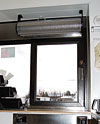
The air curtain installation at this Arby’s restaurant took 15 minutes. The unit’s universal bracket was screwed into the sheet metal header of the drive-through window’s metal framework.
The U.S. Labor Department’s Occupational Safety & Health Administration (OSHA) has listed all quick-serve restaurant (QSR) drive-through windows as a potential IAQ health hazard, and contractors should be aware of the solutions they can provide. If the 21-year-old Ohio store’s new drive-through window air curtain isn’t switched on in the morning, carbon monoxide (CO) and other airborne vehicle emission contaminants can be noticed in many areas of the restaurant.
IAQ and indoor temperature conditions are legitimate issues contractors should be aware of for these customers, because drive-through business is booming. According to the National Restaurant Association (NRA), drive-through window transactions nationwide now command 50-80 percent of total QSR business. Providing a comfortable work environment can help reduce the restaurant industry’s high turnover rate, which the NRA lists at 145 percent for hourly employees in 2006 (like those who work in the fast food industry).
Cold weather was once difficult for the 30-year-old Varga, who used to wear a heavy coat and gloves while working at the drive-through window. Now, winter days find her wearing a year-round restaurant uniform because the newly installed air curtain separates indoor and outdoor environments. On subfreezing days, the air curtain’s optional built-in electric heater is activated, supplementing the store’s interior heating.
“Before the air curtain, Jessica was dressed for the North Pole just to stay warm, and the in-store counter cashiers were also chilled on cold days,” said Vicki Vitullo, store 5775’s general manager. Vitullo welcomed air curtain manufacturer Berner International’s offer of beta site testing for its newly introduced Drive-Through Unit (DTU) last year.
“Eliminating vehicle emissions from coming into the restaurant has to be good for the employees as well as business,” Vitullo added.
TRUE TEST
Drive-through transactions represent 65 percent of the location’s total business and hundreds of customers daily; the beta test site gave the DTU a true test of performance and endurance. The 18-inch-long DTU has a 6- by 7 1/2-inch profile.Nearly a year later, the beta test air curtain is now a permanent drive-through window fixture at the leading sales location for the franchisee (Niles Restaurant Business, Youngstown). Niles is currently considering DTUs for its other eight Arby’s locations.
The DTU is similar in technology to larger back-end service door air curtains commonly used at restaurants and other foodservice operations. The DTU also eliminates flying insect infiltration. “Flies could easily buzz through the open drive-through window before, but now the air curtain has solved the fly problem too and helps us maintain our high kitchen sanitation standards,” said Vitullo.
Besides insects and employee comfort, drive-through air curtains also conserve energy. Vitullo compared several same-month utility bills in 2008 and 2009, and discovered heating costs were less after the air curtain was installed.
Energy savings is the result of separating indoor from outdoor environments. Berner International, which originally introduced air curtains to the U.S. market in 1956, strategically engineered the DTU for the air velocity, volume, and uniformity specifications that are critical to any air curtain performance. This results in a proper air discharge from top to bottom of the drive-through window opening and a maintained “split” of indoor and outdoor environments a few inches outside the threshold.
While the air discharge is strong enough to stop the infiltration of outdoor air as well as vehicle emission fumes and insects, it’s also strategically designed to not blow paper money out of hands penetrating the airstream.

Berner’s drive-through unit is similar to a larger back-end service door air curtains commonly used at restaurants and other foodservice operations. The DTU, however, also eliminates flying insect infiltration.
GROWING TREND
Air curtains have been used for decades in worldwide industrial applications to separate dissimilar environments at doorways. More recently however, retailers such as Whole Foods and Urban Outfitters have embraced air curtain technology at their front doors to conserve energy, supplement their green missions, and maintain employee comfort at point-of-purchase stations.The DTU installation at this Arby’s store took 15 minutes and caused little disruption to store operations during the retrofit, said Vitullo. The unit’s universal bracket adapts to all building materials, so it was screwed into the sheet metal header of the drive-through window’s metal framework. Powering it required plugging it into a nearby 120-V/20-amp electrical outlet.
Now when temperatures dip in Ohio, it’s not the drive-through employees’ hands and arms that are freezing; it’s only the frosty Jamocha Swirl Shake as it passes from a cozy environment, through the air curtain’s airstream, and into the customers’ vehicles.
For more information, visit www.berner.com.
Publication date:09/28/2009

Report Abusive Comment